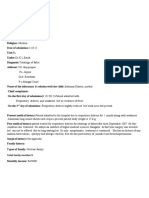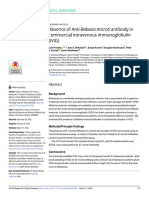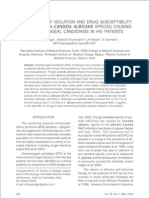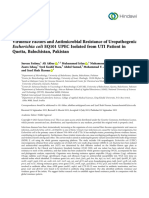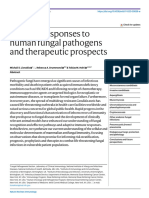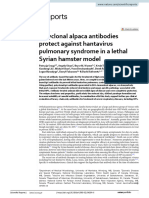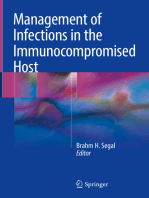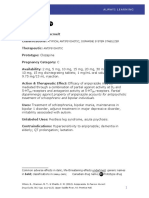PMID 36974854 Opportunistic
PMID 36974854 Opportunistic
Uploaded by
ajaya basnetCopyright:
Available Formats
PMID 36974854 Opportunistic
PMID 36974854 Opportunistic
Uploaded by
ajaya basnetCopyright
Available Formats
Share this document
Did you find this document useful?
Is this content inappropriate?
Copyright:
Available Formats
PMID 36974854 Opportunistic
PMID 36974854 Opportunistic
Uploaded by
ajaya basnetCopyright:
Available Formats
Original Article
J Nepal Health Res Counc 2022 Jul-Sep; 20 (56): 664-71
Antimicrobial Susceptibility Pattern in Opportunistic
Pathogens Isolated from Immunocompromised
Patients
Ajaya Basnet,1 Arun Bahadur Chand,2 Nayanum Pokhrel,3 Sadikchya Acharya,1 Parbati Gurung,1 Laxmi Kant
Khanal,4 Kundu Shrestha,5 Lok Bahadur Shrestha,6 Bijendra Raj Raghubanshi2
1
Department of Medical Microbiology, Shi-Gan International College of Science and Technology, Tribhuvan
University, Kathmandu, Bagmati, Nepal, 2Department of Clinical Microbiology, KIST Medical College and
Teaching Hospital, Lalitpur, Bagmati, Nepal, 3Research Section, Nepal Health Research Council, Kathmandu,
Bagmati, Nepal, 4Department of Clinical Microbiology, Nepal Medical College and Teaching Hospital,
Kathmandu, Bagmati, Nepal, 5Department of Anaesthesia and Critical care, Nepal Armed Police Force
Hospital, Kathmandu, Bagmati, Nepal, 6School of Medical Sciences and The Kirby Institute, University of
New South Wales, Sydney, Australia.
ABSTRACT
Background: Brought with the advancements in transplantation science and the development of immunosuppressive
agents, immunocompromised patients characterized with defective immunity have increased throughout the world
with increased risk for opportunistic infections. This study provides an overview of the antimicrobial susceptibility
pattern among opportunistic pathogens isolated from immunocompromised patients.
Methods: Clinical and laboratory records of immunocompromised patients [patients with chronic kidney disease
neutropenia, diabetes, rheumatic heart disease acquired immune deficiency syndrome hepatitis B, hepatitis C, who
were subjected to microbiological culture analysis in the Department of Clinical Microbiology, KIST Medical College
and Teaching Hospital, for 2 years (January 2019 and December 2020) were analyzed.
Results: Out of 8,402 immunocompromised patients, 954 (11.4%) patients were subjected to microbiological
culture analysis. Among 954 patients, 253 (26.5%) patients [median(interquartile range) age: 52(31-67) years; male
138 (54.5%)] were infected. A total of 295 pathogens were isolated from 1,331 cultured samples. Infections due
to Escherichia coli (n=71, 24.1%), Klebsiella spp. (n=55, 18.6%), Acinetobacter calcoaceticus-baumannii complex (n=35,
11.9%), Candida albicans (n=30, 10.2%), and Staphylococcus aureus (n=28, 9.5%) were frequently observed. Among
the bacterial isolates (n=239), 81.6% (n=195) of bacteria were β-lactamase producers, 51.0% (n=122) were multi-
drug resistant, 9.2% (n=195) were extensively-drug resistant, 0.8% (n=195) were pan-drug resistant, and 35.7%
(n=10) of S. aureus were methicillin-resistant Staphylococcus aureus.
Conclusions: The majority of infection in immunocompromised patients is caused by Gram-negative bacteria, and
is often associated with a higher number of β-lactamase producers and multi-drug resistant organisms. Prescriptions
of antibiotics on the grounds of antimicrobial stewardship might help to reduce the burden of antimicrobial resistance.
Keywords: Antimicrobial resistance; immunocompromised host; opportunistic infections.
INTRODUCTION to immunocompetent hosts.1-3 Such infections are
often associated with an increase in disease severity,
Immunocompromised hosts, who possess a weak
prolonged hospital admission, and increased mortality.4
immune system either as a result of genetically
heterogeneous impairment in immune systems or
The prolonged and aggressive antibiotic treatment in
due to organ transplantation, are relatively at an
the immunocompromised hosts has expanded the global
increased risk for opportunistic infections as compared
Correspondence: Mr Arun Bahadur Chand, Department of Clinical Microbiology, KIST
Medical College and Teaching Hospital, Lalitpur, Nepal. Email: arunbchand@gmail.com,
Phone: +977 9851216148.
664 JNHRC Vol. 20 No. 3 Issue 55 Jul-Sep 2022
Antimicrobial Susceptibility Pattern in Opportunistic Pathogens Isolated from Immunocompromised Patients
health risk.5 The rapid emergence of antimicrobial- Mueller-Hinton agar as per the guideline of The Clinical
resistant microbes and failure to discover the newer and Laboratory Standards Institute.10
antimicrobial agents to treat the infection associated
with multidrug-resistant (MDR), extensively-drug MDR was defined as acquired non-susceptibility to
resistant (XDR), pan-drug resistant (PDR), methicillin- at least one agent in three or more antimicrobial
resistant Staphylococcus aureus (MRSA), and β-lactamase categories, XDR was defined as non-susceptibility to at
producers has prompted immunocompromised hosts to least one agent in all but two or fewer antimicrobial
be at particularly high risk for developing and dying of categories (i.e. bacterial isolates remain susceptible
sepsis.6-8 to only one or two categories) and PDR was defined
as non-susceptibility to all agents in all antimicrobial
In this article, we have presented the prevalence, categories.7 The β-lactamase producer was defined as
organism profile, and antimicrobial susceptibility the bacterium that had resistance to any one group
pattern among opportunistic pathogens isolated from of β-lactam antibiotics, such as penicillin derivative,
immunocompromised patients. cephalosporins, monobactams, and carbapenems.10
MRSA was defined as resistance (a zone size ≤ 19mm)
of S. aureus to cefoxitin.10
METHODS
A hospital-based retrospective study was conducted in Data analysis was performed using the Statistical
the Department of Microbiology of Kist Medical College Package for the Social Sciences software version 17.0.
and Teaching Hospital (KISTMCTH), Gwarko, Lalitpur.
The study was approved by the Institutional Review
RESULTS
Committee (Ref. number: 0770788) of KISTMCTH.
Patients with immunocompromised conditions such as Out of 8,402 immunocompromised patients investigated
chronic kidney disease (CKD), neutropenia, rheumatic over a 2-year period, patients with immunocompromised
heart disease (RHD), diabetes, hepatitis B (HB), hepatitis conditions such as neutropenia (n=5628, 67.0%), diabetes
C (HC), and acquired immunodeficiency syndrome (n=1983, 23.6), CKD (n=542, 6.5%), RHD (n=204, 2.3%),
(AIDS), of any age and sex, visiting the hospital from hepatitis B (n=26, 0.3%), hepatitis C (n=13, 0.2%), and
February 1, 2019, to January 31, 2021, were traced and AIDS (n=6, 0.1%) were found. Among them, 954 (11.4%)
analyzed for microbiological culture and sensitivity. patients were clinically suspected for infection and
hence underwent a subsequent panel of microbiological
Microbiological samples such as blood, urine, investigations to confirm the presence of microbial
sputum, and other body fluids obtained from the infections (Table 1).
immunocompromised patients were subjected to
culture. All samples were inoculated onto blood agar, A total of 1,331 clinical samples from 954
chocolate agar, and MacConkey agar, except for the immunocompromised patients were processed for
urine samples, which were inoculated on cysteine microbiological findings. There were 619 (46.6%) blood,
lactose electrolyte-deficient agar. The inoculated agar 372 (27.9%) urine, 228 (17.1%) sputum, and other
plates were aerobically incubated at 35 ± 2°C for 24 infrequent body fluids that were processed for culture
hours. Fastidious bacteria such as Streptococcus spp. analysis (Table 2). Out of 954 microbiologically analyzed
were identified by gram staining (Gram-positive cocci), patients, 253 (26.5%) patients (mean age: 48.9 ± 23.9,
catalase test (catalase non-producing), bile esculin male sex: 138 [54.5%]) were infected with microbes.
test (esculin hydrolyzed by Enterococcus spp.), and Concerning the infected immunocompromised patients,
bacitracin and optochin sensitivity test. Moraxella spp there were 124 (42.0%) patients with CKD, 60 (20.3%)
were also identified by gram staining (Gram-negative with neutropenia, 59 (20.0%) with diabetes, 6 (2.0%)
coccobacilli), catalase test (catalase-producing), with RHD, 3 (1.0%) with hepatitis B, and 1 (0.3%) with
oxidase test (oxidase-producing), and nitrate reduction hepatitis C (Table 2). Samples such as sputum (n=99,
test (nitrate-reducing). Conclusively, all of the isolated 33.6%), urine (n=95, 32.2%), and blood (n=38, 12.9%)
microbial colonies were identified based on the colony were most commonly positive for the microbiological
characteristics, gram staining, and biochemical tests culture. There were 207 (70.2%) patients likely to be
following the standard microbiological guidelines.9 infected by one species identified, 26 (8.8%) patients
likely to be infected by two of the species identified,
After identification, antimicrobial susceptibility testing and 20 (6.8%) patients likely to be infected by at least 3
was performed by Kirby Bauer disc diffusion method on species (Table 2).
JNHRC Vol. 20 No. 3 Issue 55 Jul-Sep 2022 665
Antimicrobial Susceptibility Pattern in Opportunistic Pathogens Isolated from Immunocompromised Patients
Table 1. Demographics of immunocompromised and infected patients.
Immunocompromised patients
Total Microbiologically Infected
Variables
(n = 8402) analyzed (n = 253)
n (%) (n = 954) n (%) n (%)
Mean 41.1 ± 22.3 42.9 ± 24.0 48.9 ± 23.9
Age (years) Median
41 (24-59) 42 (23-63) 52 (31-67)
(Q1-Q3)
< 10 849 (10.1) 84 (8.8) 15 (5.9)
10-20 560 (6.7) 77 (8.1) 15 (5.9)
20-30 1506 (17.9) 168 (17.6) 32 (12.6)
Age groups
30-40 1176 (14.0) 127 (13.3) 34 (13.4)
(years)
40-50 1109 (13.2) 112 (11.7) 23 (9.09)
50-60 1197 (14.2) 107 (11.2) 33 (13.0)
≥ 60 2005 (23.9) 279 (29.3) 101 (39.9)
Male 4040 (48.1) 507 (53.1) 138 (54.5)
Gender
Female 4362 (51.9) 447 (46.9) 115 (45.5)
AIDS 6 (0.1) 2 (0.2) 0 (0)
HB 26 (0.3) 9 (0.9) 3 (1.19)
HC 13 (0.2) 5 (0.5) 1 (0.4)
IMC state RHD 204 (2.4) 17 (1.8) 6 (2.37)
CKD 542 (6.5) 282 (29.6) 124 (49)
Neutropenia 5628 (67.0) 459 (48.1) 60 (23.7)
Diabetes 1983 (23.6) 180 (18.9) 59 (23.3)
IMC = immunocompromised, AIDS = Acquired immunodeficiency syndrome, CKD = Chronic Kidney Disease, RHD =
Rheumatic Heart Disease, HB = Hepatitis B, HC = Hepatitis C
Table 2. Culture results based upon the type of samples.
Samples Type of infection
Samples Processed Positive culture 1 microbe 2 microbe ≥ 3 microbe
n (%) n (%) n n n
Blood 619 (46.6) 38 (12.9) 33 3 2
Others 21 (1.6) 3 (1.0) 3 0 0
Urine 372 (27.9) 95 (32.2) 73 10 12
Sputum 228 (17.2) 99 933.6) 88 8 3
Wound 12 (0.9) 5 (1.7) 4 1 0
Pus 20 (1.5) 11 (3.7) 5 4 2
CSF 19 (1.4) - - - -
Ascitic fluid 19 (1.4) 1 (0.3) 0 0 1
Pleural fluid 10 (0.7) 1 (0.3) 1 0 0
Catheter tips 11 (0.8) - - - -
Total 1331 253 207 26 20
The majority of infections were caused by E. coli (n=71, 24.1%), Klebsiella spp. (n=55, 18.6%), Acinetobacter calcoaceticus-
baumannii complex (ACB complex) (n=35, 11.9%), C. albicans (n=30, 10.2%), and S. aureus (n=28, 9.5%). There were 239
(81.0%) cases of bacterial infection, 44 (14.9%) of fungal infections, and 12 (4.1%) of polymicrobial infections (≥ 3 three
different species, specifically in the urine samples, which were neither identified nor tested for sensitivity) (Table 3).
666 JNHRC Vol. 20 No. 3 Issue 55 Jul-Sep 2022
Antimicrobial Susceptibility Pattern in Opportunistic Pathogens Isolated from Immunocompromised Patients
Table 3. Organisms isolated from different clinical samples.
Sputum Urine Blood Wound Pus Ascitic fluid Pleural fluid Others
Pathogens
(n=114) (n=109) (n=45) (n=6) (n=13) (n=2) (n=1) (n=5)
ACB complex (n=35) 23 1 6 1 2 1 0 1
Pseudomonas spp.
9 7 1 0 0 1 0 0
(n=18)
Proteus spp. (n=2) 0 2 0 0 0 0 0 0
Salmonella spp. (n=2) 0 0 2 0 0 0 0 0
Klebsiella spp. (n=55) 31 15 3 2 4 0 0 0
Enterobacter spp. (n=8) 3 2 2 0 1 0 0 0
Escherichia coli (n=71) 14 50 3 1 1 0 1 1
Citrobacter spp. (n=8) 5 0 3 0 0 0 0 0
Moraxella spp. (n=1) 1 0 0 0 0 0 0 0
Staphylococcus aureus
5 0 18 0 4 0 0 1
(n=28)
Streptococcus spp.
0 1 1 0 0 0 0 0
(n=2)
Enterococcus spp. (n=9) 0 4 4 0 1 0 0 0
Candida albicans (n=30) 18 10 0 2 0 0 0 0
Candida non-albicans
4 5 2 0 0 0 0 2
(n=13)
Aspergillus spp. (n=1) 1 0 0 0 0 0 0 0
Multiple organisms
0 12 0 0 0 0 0 0
(n=12)
ACB complex = Acinetobacter calcoaceticus-baumannii complex
Table 4. Antibiotic resistance profile of the Gram-negative bacterial isolates.
E. coli Klebsiella ACB complex Pseudomonas Citrobacter Enterobacter
Antibiotics
(n=71) spp. (n=55) (n=35) spp. (n=18) spp. (n=8) spp. (n=8)
Ampicillin 86.0 92.0 100.0 100.0 100.0 100.00
Amoxicillin-Clavulanic acid 57.1 62.5 100.0 - 12.5 66.7
Ceftriaxone 86.4 55.3 95.5 50 100.0 100.0
Cefotaxime 74.5 48.1 81.3 - 100.0 100.0
Ceftazidime 67.8 100.0 100.0 28.6 100.0 100.0
Cefepime 100.0 100.0 100.0 - 100.0 -
Nalidixic Acid 93.5 0 - - - 100.0
Ciprofloxacin 83.6 43.2 62.5 0 100.0 37.5
Ofloxacin 91.1 48.3 95.2 100.0 100.0 -
Norfloxacin 79.4 0 - - - 0
Norfloxacin 100.0 100.0 - - - -
Gentamicin 27.7 16.7 36.7 14.3 100.0 28.8
Amilkacin 18.4 58.9 39.4 12.5 12.5 -
Meropenem 4.3 25.0 100.0 28.6 100.0 -
Imipenem 55.6 71.4 90.9 - 100.0 -
Tetracyclin - 100.0 100.0 100.0 - -
Cotrimoxazole 80.3 42.3 78.8 100.0 87.5 75.0
Chloramphenicol - 75.0 18.2 - 0 0
Colistin 0 4.0 0 - 0 0
Polymixin B 0 0 0 - 0 0
Nitrofurantoin 5.17 66.7 - - - 100.0
Piperacillin/Tazobactem 50.0 66.7 10.0 25.0 - -
Tigecycline 0 0 42.1 - 0 0
JNHRC Vol. 20 No. 3 Issue 55 Jul-Sep 2022 667
Antimicrobial Susceptibility Pattern in Opportunistic Pathogens Isolated from Immunocompromised Patients
nalidixic acid, ciprofloxacin, and ofloxacin was observed
Table 5. Antibiotic resistance profile of the Gram-
for Proteus spp. Salmonella spp., and Moraxella spp.
positive bacterial isolates.
Hundred percent of S. aureus were resistant to penicillin,
S. aureus Enterococcus
Antibiotics ceftriaxone, ceftazidime, cefepime, ofloxacin,
(n=28) spp. (n=9)
imipenem, amoxicillin-clavulanic acid, and cefotaxime-
Penicillin 100.0 71.43 clavulanic, while 100% sensitivity was observed for
Ampicillin 92.6 33.33 tigecycline and vancomycin (Table 5). Streptococcus
Amoxycilli-clavulanic spp. exhibited 100% resistances to penicillin, cefoxitin,
100.0 - cefotaxime, ceftazidime, ofloxacin, gentamicin,
acid
cotrimoxazole, and meropenem. Such higher incidences
Cloxacillin 20.0 -
of antibiotic resistance could be due to fewer (n=2)
Cefoxitin 33.4 -
Streptococcus spp.
Cefotaxime 75.0 100.00
Ceftriaxone 100.0 75.00
Ceftazidime 100.0 100.00
Cefepime 100.0 -
Ciprofloxacin 37.5 100
Ofloxacin 100.0 83.33
Levofloxacin 11.11 -
Gentamicin 53.9 100.00
Amikacin 84.6 100
Clindamycin 50.0 -
Erythromycin 60.0 -
Chloramphenicol 6.3 12.50
Cotrimoxazole 29.4 100.00
Meropenem 91.7 100.00
Imipenem 100.00 -
Cefotaxime-clavulanic
100.00 -
acid
Vancomycin 0 0
Tigecycline 0 0
Fig 1. Types of antibiotic resistance.
Out of 239 bacterial isolates, 195 (81.6%) organisms
were β-lactamase producers, 122 (51.0%) were MDR, 22
(9.2%) were XDR, 2 (0.8%) were PDR, and 10 (35.7%) S. DISCUSSION
auresu were MRSA (Fig 1).
With the varying patterns of infection in
immunocompromised patients,1 the facilities of late
Bacteria-specific drug susceptibility profile has been
prognosis and/or prolonged aggressive treatment
summarized in Table 4 and Table 5. Hundred percent
practices have created challenges for practitioners,
of E. coli and Klebsiella spp. were resistant to cefepime
either by changing drug susceptibilities or by evolving
and levofloxacin, while absolute non-resistance was
standards for empirical use of the antimicrobial agents
observed for polymixin B and tigecycline. Similarly, the
against pathogens.6 Despite such facts, there are still
ACB complex showed 100% resistance to ampicillin,
limited numbers of studies concerning the burden
amoxicillin clavulanic acid combination, ceftazidime,
of microbial infection and/or superinfection among
cefepime, meropenem, and tetracycline, and 100%
immunocompromised patients. Therefore, we aimed
sensitivity to both colistin and polymixin B. Absolute
to analyze the prevalence of opportunistic infections,
(100%) resistance in Pseudomonas spp. was also
organism profile, and antimicrobial susceptibility
observed for ampicillin, ofloxacin, tetracycline, and
patterns among immunocompromised patients.
cotrimoxazole (Table 4). Absolute resistance for
ampicillin, cefotaxime, ceftriaxone, ceftazidime,
668 JNHRC Vol. 20 No. 3 Issue 55 Jul-Sep 2022
Antimicrobial Susceptibility Pattern in Opportunistic Pathogens Isolated from Immunocompromised Patients
The mean age of the immunocompromised patients in patients.13 Wisplinghoff et al.23 mentions that infections
this study was 41.1 years±22.3, which is inconsistent in immunocompromised hosts are commonly associated
with the findings of Trivedi et al.11 (55 years±14.8). with S. pneumoniae, H. influenzae, and S. aureus and
The immunocompromised patients of the age group most often with Salmonella spp., Pseudomonas spp.,
≥ 60 years (34.2%) were mostly infected, which could and Mycoplasma spp. Such infections may be due to
be attributed to the significant loss of innate immune abnormalities in either cell-mediated immunity or
and poor T-cell function.12 In this study, the majority defects in antibody or complement response developed
of males (54.5%) with the immunocompromised against the pathogen in the immunocompromised
condition were infected. This could be attributed to the host, nevertheless, resulting in pneumonia, chronic
behavioral factors such as higher levels of drinking and or disseminated fungal or viral infections, and severe
smoking among men compared to women and sex-based mycobacterial disease.24
immunological differences, mediated by sex hormone
and X chromosome.13 Our study revealed a variable degree of resistance
to many of the routinely used drugs. Tetracycline
The culture positivity rate in this study was higher for the (100%), cefepime (100%), ampicillin (95.8%), and
patients with CKD (42.0%) as compared to the patients ceftazidime (94.9%) had the highest overall resistance
with neutropenia (20.3%), diabetes (20.0%), RHD (2.0%), rate for Gram-negative bacteria. Similarly, Gram-
hepatitis B (1.0%), and hepatitis C (0.3%). In contrast to positive bacteria showed absolute non-sensitivity
our findings, several studies reported varying incidences to cefepime, ceftazidime, ceftriaxone, cefotaxime-
of bacterial infection in patients with neutropenia (21.3- clavulanic acid combination, and imipenem. Such
35.4%),14,15 CKD (13.8-17.2%),13 diabetes (19.4-63.4%),11,16 higher resistances to antibiotics among bacteria could
hepatitis B (28.1-36.8%),17,18 and hepatitis C (38.3- be due to the modification in their cell permeability;
78.6%).19,20 The increased rate of bacterial infections in drug degradation/alteration by enzymes such as beta-
patients with CKD from our study could be accredited lactamase, aminoglycoside-modifying enzymes, or
to dialysis-related problems like repeated skin puncture acetyltransferases; and efflux pump expression, which
and reduced immunity.21 Additionally, the observation of results in reduced intracellular drug accumulation.25,26
fewer microbial infections in hepatitis-infected patients In this study, while Gram-negative bacteria showed
and no microbial infections in HIV-infected patients in better sensitivity towards polymyxin B (100%), colistin
this study was due to the lower frequency of hepatitis- (99.08%), and tigecycline (92.7%), Gram-positive
infected and HIV-infected patients visiting the hospital. bacteria showed better sensitivity towards vancomycin
(100%), tigecycline (100%), and chloramphenicol (92%).
We observed respiratory tract infections (39.43%) as An absolute resistance of E. coli and Klebsiella spp. to
the obvious source of infection in immunocompromised cefepime and levofloxacin was observed. Both of them
patients, which contrasts with the finding of Adhikari et were sensitive to polymyxin B and tigecycline. ACB
al.,22 who had reported urinary tract infection (36.57%) complex showed 100% resistance to ampicillin,
to be the commonest infection among such patients. amoxiclav, ceftazidime, cefepime, meropenem, and
Though the lower incidence of bloodstream infection tetracycline, and 100% sensitivity to both colistin and
(16.57%) from our study was similar to the findings from polymixin B. A study mentions ACB complex as a highly
several studies,15,22 it was inconsistent with the findings antimicrobial-resistant pathogen, and accredited its
of Taj et al.14 (46.01%), who have reported a higher potency to its property of clonal expansion.27 A high level
rate of bloodstream infections in immunocompromised of resistance in β-lactam antibiotics was also observed
patients. The probable reason for the lower rate of in a study by Shrestha et al.,7 who had reported 35%
bloodstream infection in our study could be accountable of E. coli and K. pneumoniae to be a β-lactamases
to the fact that many patients could have received producers. Nevertheless, such ability of Gram-negative
empirical antibiotics before blood culture analysis.14 bacteria to alter the outer membrane, either by
changing the hydrophobic properties or by mutations
Most of the immunocompromised patients from this in porins, which hinders the passage for drugs, makes
study were infected with E. coli (24.1%), Klebsiella spp. them more resistant to antibiotics than Gram-positive
(18.6%), ACB complex (11.9%), C. albicans (10.2%), pathogens.28 Concerning the Gram-positive bacteria in
and S. aureus (9.5%). Similar pathogens were also this study, hundred percent of S. aureus were sensitive
isolated from the National Kidney Center of Nepal to vancomycin and tigecycline. While Enterococcus spp.
during a study in CKD patients22 and several other was moderately resistant to ampicillin and ofloxacin in
studies conducted in diabetic patients11 and neutropenic this study, other Streptococcus spp. was resistant to
JNHRC Vol. 20 No. 3 Issue 55 Jul-Sep 2022 669
Antimicrobial Susceptibility Pattern in Opportunistic Pathogens Isolated from Immunocompromised Patients
them. 3. Alvarez B, Arcos J, Fernandez-Guerrero ML.
Pulmonary infectious diseases in patients with primary
The incidence rate of MDR (51.0%), XDR (9.2%), PDR immunodeficiency and those treated with biologic
(0.8%), and MRSA (35.7%) were comparable to the immunomodulating agents. Curr Opin Pulm Med.
findings of Shrestha et al.,7 who had also reported the 2011;17(3):172-9. [PubMed | Full Text]
incidence rate of MDR, XDR, PDR, and MRSA to be 40%,
10%, 0%, and 30%, respectively. Very high incidences of 4. Klein EY, Monteforte B, Gupta A, Jiang W, May L, Hsieh
β-lactamase producers (81.6%) observed in this study YH, et al. The frequency of influenza and bacterial
were discordant with the findings of Shrestha et al.,7 coinfection: a systematic review and meta‐analysis.
who had reported 35% of E. coli and Klebsiella spp. as Influenza Other Respir Viruses. 2016;10(5):394-403.
the β-lactamase producers. [PubMed | Full Text ]
This study suffers from several limitations. Firstly, 5. DeNegre AA, Ndeffo Mbah ML, Myers K,
patients, who have cancer and are on chemotherapy, Fefferman NH. Emergence of antibiotic resistance in
or who have had a solid organ transplant such as kidney immunocompromised host populations: A case study
or heart transplant, and are taking medication to keep of emerging antibiotic resistant tuberculosis in AIDS
their transplant were not included. Secondly, this is patients. PloS One. 2019;14(2):e0212969. [PubMed |
a single-center cross-sectional study comprising the Full Text]
Nepalese population who visited the study site seeking
medical care, and therefore the findings may not be 6. Moriyama B, Henning SA, Childs R, Holland SM,
generalizable in the worldwide context. Hence, further Anderson VL, Morris JC, et al. High-dose continuous
well-designed studies with a larger sample size are infusion β-lactam antibiotics for the treatment of
required. resistant Pseudomonas aeruginosa infections in
immunocompromised patients. Ann Pharmacother.
2010;44(5):929-35. [PubMed | Full Text]
CONCLUSIONS
This study showed an infection rate of 26.5% in 7. Shrestha LB, Bhattarai NR, Khanal B. Bacteriological
immunocompromised patients. E.coli, Klebsiella spp., Profile and Antimicrobial Susceptibility Pattern among
ACB complex, C. albicans, and S. aureus are the Isolates Obtained From Body Fluids. Nepal Health Res
frequently encountered organisms, most of which Counc. 2019;17(2):173-7. [PubMed | Full Text]
are β-lactamase producers and multi-drug resistant.
Bacterial infections showing considerable resistance to 8. Lin GL, McGinley JP, Drysdale SB, Pollard AJ.
the commonly used antibiotics call for the strategies Epidemiology and immune pathogenesis of viral sepsis.
to prescribe antibiotics on the grounds of antimicrobial Front Immunol. 2018;9:2147. [PubMed | Full Text]
stewardship principles in order to reduce morbidity and
mortality in immunocompromised patients. 9. Procop GW, Church DL, Hall GS, Janda WM. Koneman's
color atlas and textbook of diagnostic microbiology. Jones
& Bartlett Publishers; 2020 Jun 29.
CONFLICT OF INTEREST
The authors declare no conflict of interest. 10. Clinical and Laboratory Standards Institute. CLSI
document M100S. Performance Standards for
Antimicrobial Susceptibility Testing. 26th ed. Wayne, PA.
REFERENCES 2016.
1. Mortaz E, Tabarsi P, Mansouri D, Khosravi A, Garssen J,
Velayati A, et al. Cancers related to immunodeficiencies: 11. Trivedi U, Parameswaran S, Armstrong A, Burgueno-Vega
update and perspectives. Front Immunol. 2016;20(7):365. D, Griswold J, Dissanaike S, et al. Prevalence of multiple
[PubMed | Full Text ] antibiotic resistant infections in diabetic versus nondiabetic
wounds. Journal of pathogens. 2014;2014:173053. [Full
2. Mascelino MT, Raponi G, Oliva A, Mastroanni CM, Text]
Vullo V. Candidaemia in immune-compromised hosts:
incidence and drug susceptibility. J. Clin. Exp. Pathol. 12. Sutherland AG, Cook A, Miller C, Duncan L, Yuecel R,
2012;2(131):2. [Full Text] Heys SD, et al. Older patients are immunocompromised
by cytokine depletion and loss of innate immune function
670 JNHRC Vol. 20 No. 3 Issue 55 Jul-Sep 2022
Antimicrobial Susceptibility Pattern in Opportunistic Pathogens Isolated from Immunocompromised Patients
after HIP fracture surgery. Geriatr Orthop Surg Rehabil. 21. Lai SW, Lin CL, Liao KF. Risk of contracting pneumonia
2015;6(4):295-302. [PubMed | Full Text] among patients with predialysis chronic kidney disease:
a population-based cohort study in Taiwan. Biomedicine.
13. Bwire GM. Coronavirus: why men are more vulnerable 2017;7(3). [PubMed | Full Text]
to Covid-19 than women?. SN comprehensive clinical
medicine. 2020 Jul;2(7):874-6. [PubMed | Full Text] 22. Adhikari L. Incidence of bacterial infections in chronic
kidney disease patients admitted in nephrology unit of
14. Taj M, Farzana T, Shah T, Maqsood S, Ahmed SS, Shamsi Kathmandu Medical College Teaching Hospital. Journal
TS. Clinical and microbiological profile of pathogens in of Kathmandu Medical College. 2018;7(1):26-9. [Full
febrile neutropenia in hematological malignancies: A Text | DOI]
single center prospective analysis. Journal of oncology.
2015;2015:596504. [PubMed | Full Text] 23. Wisplinghoff H, Seifert H, Wenzel RP, Edmond MB.
Current trends in the epidemiology of nosocomial
15. Jacob LA, Lakshmaiah KC, Govindbabu K, Suresh TM, bloodstream infections in patients with hematological
Lokanatha D, Sinha M, et al. Clinical and microbiological malignancies and solid neoplasms in hospitals in the
profile of febrile neutropenia in solid tumors and United States. Clinical Infectious Diseases. 2003 May
hematological malignancies at a tertiary cancer care 1;36(9):1103-10. [PubMed | Full Text]
center in South India. Indian J Cancer. 2014;51(4):464.
[PubMed | Full Text] 24. Dropulic LK, Lederman HM. Overview of infections in
the immunocompromised host. Diagnostic microbiology
16. Simonsen JR, Harjutsalo V, Järvinen A, Kirveskari J, of the immunocompromised host. 2016 Aug 15:1-50.
Forsblom C, Groop PH, et al. Bacterial infections in [PubMed | Full Text]
patients with type 1 diabetes: a 14-year follow-up study.
BMJ Open Diabetes Res Care. 2015;3(1). [PubMed | 25. Santajit S, Indrawattana N. Mechanisms of antimicrobial
Full Text] resistance in ESKAPE pathogens. BioMed research
international. 2016 Oct;2016. [PubMed | Full Text]
17. Li W, Jin R, Chen P, Zhao G, Li N, Wu H. Clinical
correlation between HBV infection and concomitant 26. Richa C, Bhushan CS, Kumar SP, Dev PN, Nabaraj P.
bacterial infections. Sci Rep. 2015;5(1):1-6. [PubMed | Bacteriology of urinary tract infection of chronic renal
Full Text] failure patients undergoing for hemodialysis. J Microbiol
Exp. 2016;3(3):00089. [Full Text ]
18. Cao ZJ, Liu YH, Zhu CW, Yin S, Wang WJ, Tang WL, et
al. Bacterial infection triggers and complicates acute-on- 27. Chaudhary BR, Malla KK, Poudel S, Jha BK. Study of
chronic liver failure in patients with hepatitis B virus- Antibiotic Susceptibility among Bacterial Isolates in
decompensated cirrhosis: A retrospective cohort study. Neonatal Intensive Care Unit of a Tertiary Care Hospital:
World J Gastroenterol.. 2020;26(6):645. [PubMed | Full A Descriptive Cross-sectional Study. J Nepal Med Assoc.
Text] 2020;58(231):893. [Full Text | DOI]
19. Chebrolu P, Colombo RE, Gallaher TR, Atwater S, 28. Breijyeh Z, Jubeh B, Karaman R. Resistance of gram-
Kintziger KW, Baer S, et al. Bacteremia in hemodialysis negative bacteria to current antibacterial agents and
patients with hepatitis C. Am J Med Sci. 2015;349(3):217- approaches to resolve it. Molecules. 2020 Jan;25(6):1340.
21. [PubMed | Full Text] [PubMed | Full Text]
20. Chandra N, Joshi N, Raju YS, Kumar A, Teja VD. Hepatitis
B and/or C co-infection in HIV infected patients: a study
in a tertiary care centre from South India. Indian J Med
Res. 2013;138(6):950. [PubMed | Full Text]
JNHRC Vol. 20 No. 3 Issue 55 Jul-Sep 2022 671
You might also like
- Case Presentation On TOFDocument19 pagesCase Presentation On TOFJay PaulNo ratings yet
- 3 Saritanayak EtalDocument7 pages3 Saritanayak EtaleditorijmrhsNo ratings yet
- CE (Ra1) F (SHU) PF1 (AG OM) PFA-2 (KM AG) PB2 (AG KM) PN (KM)Document6 pagesCE (Ra1) F (SHU) PF1 (AG OM) PFA-2 (KM AG) PB2 (AG KM) PN (KM)Snehashis KoleyNo ratings yet
- CarmelliDocument5 pagesCarmellinana PrimasantiNo ratings yet
- Antibiogram Final SherifDocument24 pagesAntibiogram Final Sherifmohamedbakry75No ratings yet
- Bloodstream Infections in Hospitalized Children: Epidemiology and Antimicrobial SusceptibilitiesDocument4 pagesBloodstream Infections in Hospitalized Children: Epidemiology and Antimicrobial SusceptibilitiesrasioputraNo ratings yet
- 3888 PDFDocument11 pages3888 PDFwafa2.line1No ratings yet
- Antimicrobial Resistance Global JournalDocument5 pagesAntimicrobial Resistance Global JournalAnonymous WgypolU4gNo ratings yet
- MHVQZMT EN0 C 2 A TG 1 B UJJYVNt MGZJZZ 09Document2 pagesMHVQZMT EN0 C 2 A TG 1 B UJJYVNt MGZJZZ 09Valentina D BrunaNo ratings yet
- Mljgoums v18n2p16 enDocument3 pagesMljgoums v18n2p16 enmesofathi3No ratings yet
- Biomarcadores en La Sepsis - 2024Document9 pagesBiomarcadores en La Sepsis - 2024drjosefonseca.surgeonNo ratings yet
- Antibiotic Susceptibility Patterns of Methicillin Resistant Staphyl - PDF NIHDocument5 pagesAntibiotic Susceptibility Patterns of Methicillin Resistant Staphyl - PDF NIHzia ul RahmanNo ratings yet
- Identification and Construction of A Multi Epitopes Vaccine Design Against Klebsiella Aerogenes: Molecular Modeling StudyDocument16 pagesIdentification and Construction of A Multi Epitopes Vaccine Design Against Klebsiella Aerogenes: Molecular Modeling StudySamer ShamshadNo ratings yet
- Accepted ManuscriptDocument23 pagesAccepted ManuscriptMrcom HvqyNo ratings yet
- Antibiotics 12 00459Document12 pagesAntibiotics 12 00459kavimicro23No ratings yet
- BBRC Vol 14 No 04 2021-69Document7 pagesBBRC Vol 14 No 04 2021-69Dr Sharique AliNo ratings yet
- Journal PNTD 0012035Document8 pagesJournal PNTD 0012035ALLAN COSTA GOMESNo ratings yet
- Masyeni S Et Al 2018 - Antimicrobial Susceptibility Pattern of Pathogens Isolated From Various Specimens in Denpasar-BaliDocument10 pagesMasyeni S Et Al 2018 - Antimicrobial Susceptibility Pattern of Pathogens Isolated From Various Specimens in Denpasar-BaliGilbert LazarusNo ratings yet
- Commonly Occurring Bacteria in Diabetic Foot Infections and Their Sensitivity To Various AntibioticsDocument5 pagesCommonly Occurring Bacteria in Diabetic Foot Infections and Their Sensitivity To Various Antibioticsdoctor wajiha100% (1)
- Antibiotics 11 01326 v2Document10 pagesAntibiotics 11 01326 v2hawamasfufahNo ratings yet
- Epidemiology Roun1Document10 pagesEpidemiology Roun1FebniNo ratings yet
- Journal Homepage: - : Manuscript HistoryDocument11 pagesJournal Homepage: - : Manuscript HistoryIJAR JOURNALNo ratings yet
- Evaluation of Multidrug Resistance in Bacteria Isolates From A Tertiary Care Hospital in Abakiliki MetropolisDocument4 pagesEvaluation of Multidrug Resistance in Bacteria Isolates From A Tertiary Care Hospital in Abakiliki MetropolisScivision PublishersNo ratings yet
- 16 4170okeDocument4 pages16 4170okeFenni OktoberryNo ratings yet
- Antibiotic Susceptibility Profile and Prevalence of AmpC Among Clinical Bacterial Isolates Obtained From Northwestern NigeriaDocument9 pagesAntibiotic Susceptibility Profile and Prevalence of AmpC Among Clinical Bacterial Isolates Obtained From Northwestern NigeriaUMYU Journal of Microbiology Research (UJMR)No ratings yet
- Virulence Factors and Antimicrobial Resistance of Uropathogenic Escherichia Coli EQ101 UPEC Isolated From UTI Patient in Quetta, Balochistan, PakistanDocument12 pagesVirulence Factors and Antimicrobial Resistance of Uropathogenic Escherichia Coli EQ101 UPEC Isolated From UTI Patient in Quetta, Balochistan, Pakistansam.casvab7No ratings yet
- Life 13 01126Document14 pagesLife 13 01126s4cdbv4xjrNo ratings yet
- Blrincon - Blrincon - 2023 Nature ReviewsDocument20 pagesBlrincon - Blrincon - 2023 Nature ReviewsDavidf VillabonaNo ratings yet
- Cancers Related To Immunodeficiencies: Update and PerspectivesDocument13 pagesCancers Related To Immunodeficiencies: Update and PerspectivesHabiby Habibaty QolbiNo ratings yet
- Epidemiology and Antibiotic Resistance of Uropathogenic Bacteria Isolated at Thierno Birahim Ndao Regional Hospital Center in KaffDocument6 pagesEpidemiology and Antibiotic Resistance of Uropathogenic Bacteria Isolated at Thierno Birahim Ndao Regional Hospital Center in KaffScivision PublishersNo ratings yet
- Bacteriological Profile and Drug Susceptibility Patterns in Dacryocystitis Patients Attending Gondar University Teaching Hospital, Northwest EthiopiaDocument17 pagesBacteriological Profile and Drug Susceptibility Patterns in Dacryocystitis Patients Attending Gondar University Teaching Hospital, Northwest EthiopiaDaisa RosianaNo ratings yet
- Analysis of Blood Culture Profile and Factors Related To Microbial Patterns and Antibiotic Resistance in Intensive Care UnitDocument6 pagesAnalysis of Blood Culture Profile and Factors Related To Microbial Patterns and Antibiotic Resistance in Intensive Care UnitInternational Journal of Innovative Science and Research TechnologyNo ratings yet
- Gevher Nesibe Journal of Medical & Health SciencesDocument8 pagesGevher Nesibe Journal of Medical & Health SciencesTrengginas AjiNo ratings yet
- 2020 Antibiotic-Resistant Infections and Treatment Challenges in the Immunocompromised HostDocument27 pages2020 Antibiotic-Resistant Infections and Treatment Challenges in the Immunocompromised Hosthamid rahimiNo ratings yet
- Journal Homepage: - : IntroductionDocument7 pagesJournal Homepage: - : IntroductionIJAR JOURNALNo ratings yet
- Pathogens 11 01092 v2Document12 pagesPathogens 11 01092 v2nabilla putriNo ratings yet
- Journal Pone 0289773Document25 pagesJournal Pone 0289773Desye MeleseNo ratings yet
- journal.pone.0274423Document13 pagesjournal.pone.0274423seilla manja rahmadinaNo ratings yet
- Antibiotics 13 00275Document13 pagesAntibiotics 13 00275muhammad wajahatNo ratings yet
- Epidemiology RoundDocument13 pagesEpidemiology RoundFebniNo ratings yet
- 1 s2.0 S0002934322007227 MainDocument8 pages1 s2.0 S0002934322007227 MainMaryatiNo ratings yet
- Ceftri Vs StaphyDocument12 pagesCeftri Vs StaphyFarhan Athallah RafifNo ratings yet
- Contamination Des PouletsDocument18 pagesContamination Des PouletsSomda K MariusNo ratings yet
- Gannavaram 2014Document10 pagesGannavaram 2014Shital BishtNo ratings yet
- Polyclonal Alpaca Antibodies Protect Against Hantavirus Pulmonary Syndrome in A Lethal Syrian Hamster ModelDocument9 pagesPolyclonal Alpaca Antibodies Protect Against Hantavirus Pulmonary Syndrome in A Lethal Syrian Hamster ModelMohammad ZabehNo ratings yet
- Jurnal Interna 123456Document9 pagesJurnal Interna 123456vonnyandira28No ratings yet
- Adhikari2012 JID Staph Exotoxin Sepsis AntibodiesDocument9 pagesAdhikari2012 JID Staph Exotoxin Sepsis AntibodieshamzehNo ratings yet
- Microbiological Profiles of Neonatal Sepsis in Northern EgyptDocument12 pagesMicrobiological Profiles of Neonatal Sepsis in Northern EgyptAhmed AmerNo ratings yet
- Antibiotic Sensitivity Pattern of Gram Negative BaDocument4 pagesAntibiotic Sensitivity Pattern of Gram Negative BaRaffaharianggaraNo ratings yet
- Antibiotico YPronosticoDocument6 pagesAntibiotico YPronosticoagonzale52No ratings yet
- 2015 The Comparison Between Microhematocrit and Automated Methods For Hematocrit DeterminationDocument10 pages2015 The Comparison Between Microhematocrit and Automated Methods For Hematocrit DeterminationAgri Febria SariNo ratings yet
- Metabolites BioactiveDocument23 pagesMetabolites BioactiveS. BalaNo ratings yet
- s41598-020-64934-0Document15 pagess41598-020-64934-0ansajaved786786No ratings yet
- GHFBB S47Document6 pagesGHFBB S47indra maulanaNo ratings yet
- preprints202411.1194.v1Document32 pagespreprints202411.1194.v1shoghik.hakobyan.96No ratings yet
- Abdulla 2021Document20 pagesAbdulla 2021Ogunleke AdebolaNo ratings yet
- Isolation of Bacterial Pathogens Causing Urinary Tract Infections and Their Antimicrobial Susceptibility Pattern Among Patients atDocument5 pagesIsolation of Bacterial Pathogens Causing Urinary Tract Infections and Their Antimicrobial Susceptibility Pattern Among Patients atScivision PublishersNo ratings yet
- Biology 11 01466Document21 pagesBiology 11 01466Robert StryjakNo ratings yet
- ArticleDocument16 pagesArticleTunde OdetoyinNo ratings yet
- A Prospective Study of Bloodstream Infections Among Febrile Adolescents and Adults Attending Yangon General Hospital, Yangon, MyanmarDocument22 pagesA Prospective Study of Bloodstream Infections Among Febrile Adolescents and Adults Attending Yangon General Hospital, Yangon, MyanmarHtet Lin OoNo ratings yet
- Management of Infections in the Immunocompromised HostFrom EverandManagement of Infections in the Immunocompromised HostBrahm H. SegalNo ratings yet
- Clinical Applications of Detecting IgG, IgM or IgA Antibody For TheDocument8 pagesClinical Applications of Detecting IgG, IgM or IgA Antibody For Theajaya basnetNo ratings yet
- Five Simple Rules To Avoid PlagiarismDocument3 pagesFive Simple Rules To Avoid Plagiarismajaya basnetNo ratings yet
- Overview and Principles of Scientific WritingDocument4 pagesOverview and Principles of Scientific Writingajaya basnetNo ratings yet
- Papers Desk RejectionDocument9 pagesPapers Desk Rejectionajaya basnetNo ratings yet
- 3 PMID 38289759 Human PapillomavirusDocument3 pages3 PMID 38289759 Human Papillomavirusajaya basnetNo ratings yet
- PMID 37203906 Ag-RDTDocument6 pagesPMID 37203906 Ag-RDTajaya basnetNo ratings yet
- Micro ImmunoDocument5 pagesMicro Immunoajaya basnet100% (2)
- PMID 36550723 SyphiliticDocument6 pagesPMID 36550723 Syphiliticajaya basnetNo ratings yet
- MRNA 1273 P301 ProtocolDocument135 pagesMRNA 1273 P301 ProtocolZerohedge100% (1)
- Necrosis Vs ApoptosisDocument9 pagesNecrosis Vs Apoptosissabhansali78No ratings yet
- Examen Englezä SesiuneDocument6 pagesExamen Englezä Sesiuneantonia aNo ratings yet
- Table 8-7 - The Eating Disorders and Subtypes From DSM-5Document1 pageTable 8-7 - The Eating Disorders and Subtypes From DSM-5Dragutin PetrićNo ratings yet
- Medicine FMGE Sprint by Dr. Santosh Patil (PW Med Ed)Document31 pagesMedicine FMGE Sprint by Dr. Santosh Patil (PW Med Ed)Stella ParkerNo ratings yet
- Abnormal Breathing PatternsDocument5 pagesAbnormal Breathing PatternsJonalyn EtongNo ratings yet
- Eczema - Final Thesis Edited 22.8.09Document152 pagesEczema - Final Thesis Edited 22.8.09579Rishikesh SavardekarNo ratings yet
- Skin Diseases of The Dog and CatDocument313 pagesSkin Diseases of The Dog and CatIvanov CastellanosNo ratings yet
- Kode Icd-10 C.F.H.Document15 pagesKode Icd-10 C.F.H.norierawati wahabNo ratings yet
- Ayurvedic Management of Cirrhosis of Liver With Portal Hypertension - A Case ReportDocument8 pagesAyurvedic Management of Cirrhosis of Liver With Portal Hypertension - A Case ReportIJAR JOURNALNo ratings yet
- Blue and White Illustrated Medical Healthcare in The 21st Century Education PresentationDocument32 pagesBlue and White Illustrated Medical Healthcare in The 21st Century Education PresentationMaria Victoria A. PraxidesNo ratings yet
- Chapter 5 Unit 4 Pharmacognosy Drugs Acting On Nervous System Noteskarts Pharmacognosy NotesDocument6 pagesChapter 5 Unit 4 Pharmacognosy Drugs Acting On Nervous System Noteskarts Pharmacognosy NotesDa BrokeyNo ratings yet
- Pediatric Board Certification and Recertification Review and - PDF Version 1Document822 pagesPediatric Board Certification and Recertification Review and - PDF Version 1della mouradNo ratings yet
- Unit 2 Nursing Assessment: Word TranslationDocument6 pagesUnit 2 Nursing Assessment: Word TranslationJulia KostrenkovaNo ratings yet
- Anu Omr Long CaseDocument29 pagesAnu Omr Long CaseAnurtha AnuNo ratings yet
- Nursing Health HistoryDocument9 pagesNursing Health HistoryJajangNo ratings yet
- Family Vibrionaceae: Genus / Species Characteristics Laboratory DiagnosisDocument2 pagesFamily Vibrionaceae: Genus / Species Characteristics Laboratory DiagnosisJesette KhoNo ratings yet
- Report 3Document2 pagesReport 3rakeshpuri9949No ratings yet
- Questionnaire On Clinical Chemistry For Students1 1Document9 pagesQuestionnaire On Clinical Chemistry For Students1 1Inah Mae Coleen Capuyan100% (1)
- Rabia Poster ComposrDocument1 pageRabia Poster ComposrRabia TinnaNo ratings yet
- Paper Consultation & ConsolidationDocument11 pagesPaper Consultation & ConsolidationSindy RosdianasNo ratings yet
- Lenvima Kapsul 4 MG - Lenvatinib - DKI1747700101A1 - 2020Document39 pagesLenvima Kapsul 4 MG - Lenvatinib - DKI1747700101A1 - 2020Efi OctavianyNo ratings yet
- تجميعات غادة لشهر MayDocument89 pagesتجميعات غادة لشهر MayMohamed OsamaNo ratings yet
- AripiprazoleDocument4 pagesAripiprazoleAP TOROBX100% (1)
- 4 - Clinical Patterns in Crohn's Disease - A Statistical Study of 615 CasesDocument9 pages4 - Clinical Patterns in Crohn's Disease - A Statistical Study of 615 CasesVân NguyễnNo ratings yet
- Eating DisordersDocument15 pagesEating DisordersJana Marie CorpuzNo ratings yet
- # Davidson - Review # Respiratory - MedicineDocument18 pages# Davidson - Review # Respiratory - Medicineemtiaz zamanNo ratings yet
- Enfermedad de Lyme (Neuroborreliosis) - ContinuumDocument16 pagesEnfermedad de Lyme (Neuroborreliosis) - ContinuumNeurología RebagliatiNo ratings yet
- Benign Anorectal Conditions: Ahmed Badrek-AmoudiDocument20 pagesBenign Anorectal Conditions: Ahmed Badrek-AmoudiAna De La RosaNo ratings yet
